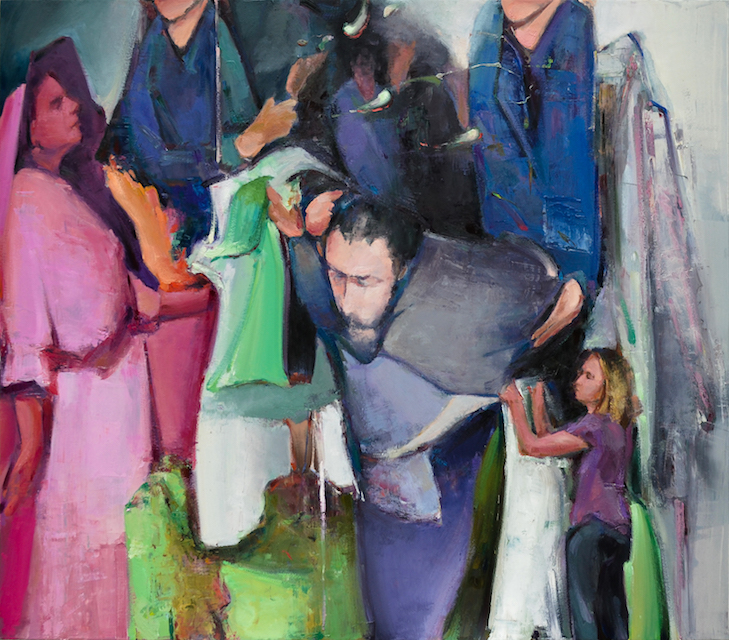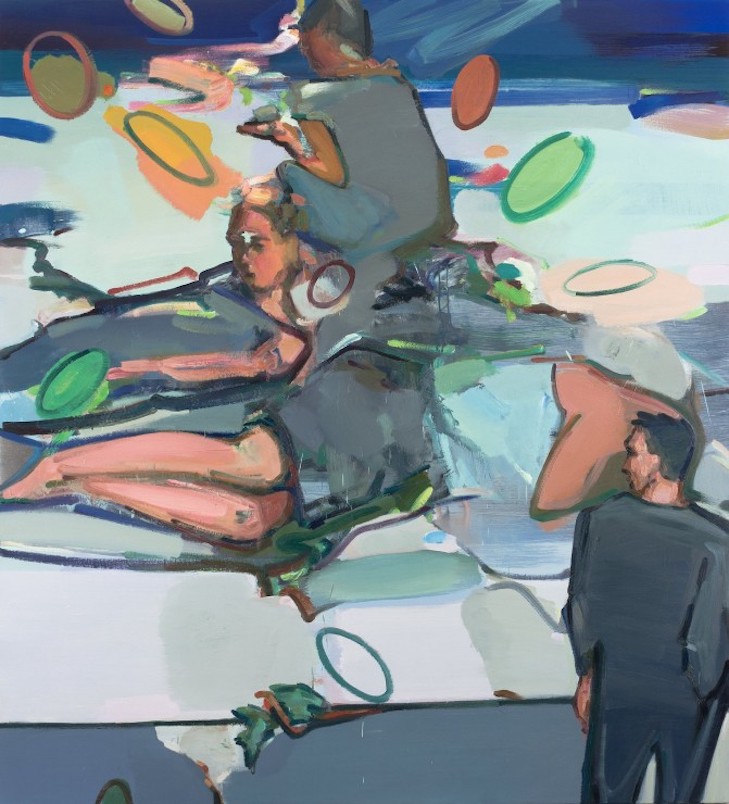CONVERSATIONS The brushstrokes of Andrius Zakarauskas

Andrius, we first spoke with you exactly one year ago, when you had a solo show in Berlin at the Magic Beans Gallery. In retrospect, how was the show perceived by the public and what was your personal experience in Berlin regarding your stay?
I still remember very clearly my first impression when I stepped out the car next to magic beans gallery – and Ai Wei Wei just passed by. I thought that it’s a good start for my Berlin visit. I showed up at the opening with a huge band of my friends. The entire exhibition was very thoroughly organised by the gallery members. There were a few press releases in the local Berlin newspapers before the opening of the exhibition, which already was a good sign. It was a very pleasant evening. As I was showing the freshest works there I was really excited to present them firstly in Berlin and was very curious how the audience would receive them as I was still living them myself. So the Wallscape exhibition was a really good start for the 2018 exhibitions to come.

I remember you saying about your paintings: “I always want to go further; I always ask myself what comes afterwards, how can I tell the viewer more.“Referring to this quote, please tell us about your year and if possible also describe it in three words if you can!
After the exhibition in Berlin, I started intensively working on my new project which I had in my head for a while. I wanted to paint the stations of the Cross and find my own interpretation for each of them. I wanted the viewer to engage with them from another direction. I have been working on that for more then a year. As a friend of my, the artist Kaido Ole said: it´s like going back to the roots. That’s how this period of working feels like to me. I try to look at them with dally routine glance. As for example, I painted “Jesus falls for the third time” in a scene of Bloody Sunday on January the 13th, at night in 1991. (Andrius is referring to the events in Lithuania which happened on the 13th of January in 1991, when the Soviet army attacked Lithuania.)

Starting with the exhibition in Berlin 2018 was an intense year. Afterwards I had a very interesting experience with Viktoras Butkus, the founder of MO museum. He was filming the whole process of me making the painting. It was quite an unusual way of working to me. I had also half a year to prepare my solo exhibition “Three Brushstrokes” in cooperation with the Rooster gallery at the Xin Dong Cheng gallery in Beijing. The title of the exhibition alludes to its structure – it falls into three parts conveying different periods of my work starting in 2008 until 2018 and reflecting the multifaceted nature of my paintings. It was the event of the year for me.
I was the first Lithuanian artist to ever have a solo exhibition in the whole of China, so I was very excited to present my works over there and curious to see how they would be accepted. As my works have a utopic, idealistic painter’s story and some of them have even a religious background.

Afterwards we had a huge event in cultural life in Lithuania – the MO museum opening where the director of Vilnius City opera Dalia Ibelpauptaite, the video artist Rimas Sakalauskas and I had a project entitled “Moving pictures” which was shown during the opening days of the museum. My paintings were transformed into video installations and accompanied by classical music.
Coming back to your question to describe my 2018 year in three words it would be: goose bumps excitement!
You have spending quite some Time in Bamberg at the Villa Concordia for an artist residency and produced a very interesting body of work.
I have been in Bamberg already for nearly 5 months now and had the Veroera exhibition recently. Veroera is a visual story of a woman, told through the narrative of the 6th station of the Cross – Veronica wipes the face of Jesus.
The story of this station is strongly connected with a painting process and focuses on Veronica’s veil and the image of Christ’s face impressed on the veil, called the true image or, in Latin, vera icon.
This act of the face touching the veil becomes a metaphor of both the painting process and the main task of the painter, the trueness of the image. The story of Veronica evolved into a series of paintings and photographs, created during the residence in Villa Concordia.
I have used the biblical story as a starting point to address related themes of physicality of the painting process, status of the work of art and image making in general. Each work complements the initial story and conveys different aspects of it.
The female figure is the key motif of the artworks, embodying the emotional, sensual, lyrical and romantic connotations of the subject.

How did you like staying in such a historical, traditional and old town like Bamberg? Are there any similarities to Lithuania?
It’s a small and a quiet town. I am very pleased to be here as I have everything I need to concentrate on my painting. I live on the banks of the river; my studio is a few minutes walk away. The Villa Concordia staff are very helpful to solve any issues I may encounter. I am really grateful for the gift to be here. In comparison with Vilnius, I would not say that there only similarities are that both cities are old. I am still getting used to the fact that people wait for the traffic light to turn green in order to cross the street, even if there is no traffic at that moment. Such behaviour is quite rare to see in Vilnius.

This is maybe an uncomfortable question, but it is really important to me. I was recently visiting the Kaunas in Art Festival, invited by Meno Parkas Gallery who also represent – among many other artists – Jonas Gasiunas who resigned from his position as an art lecturer due to several sexual harassment allegations by former students. What is your opinion on this situation? Especially if you really like an artist’s work but then you have this kind of information, do you look differently at his work?
There is a saying that you do not have to be a good person to make art. I am really fond of the paintings J. Gasiunas makes. They still inspire me, as I still refer to myself as his student. In general I am glad that people are not afraid to talk about it and the story came out due to the whole me too vibe in the world. As for myself, I still dream to have a painting by him one day.

When I was visiting Vilnius before our flight back with the Meno Parkas Gallery squad as well as some other artists, we got to visit the new MO Museum in Vilnius and it was so great to see your work and have the opportunity to explore such a wide range of contemporary Lithuanian art. I felt like a door was opened.
Yes, I am really happy that the MO museum opened eventually. At last we have a private museum in Lithuania. Not to mention the joy to be part of their collection!
As an artist, how would you wish to be seen by the “world outside”?
I always want that the image I create not only finds the viewer, but also touches her or him. As an artist, I always want my creation to somehow effect people. I think that’s one of the most crucial things that an artist could desire.
Of course, as I cannot live without painting I wish that the world could not live without my paintings!
Follow Andrius Zakarauskas on his Instagram Account!

